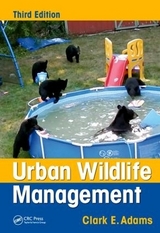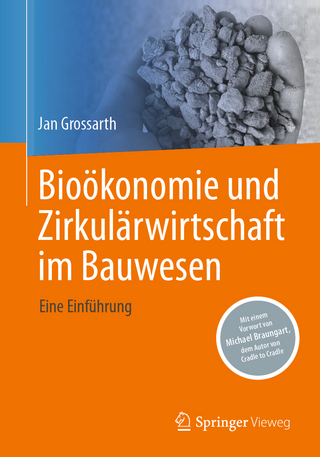
Urban Wildlife Management, Second Edition
Crc Press Inc (Verlag)
978-1-4398-0460-5 (ISBN)
- Titel erscheint in neuer Auflage
- Artikel merken
When the first edition of Urban Wildlife Management was published two years ago, it provided conservationists, ecologists, and wildlife professionals with a welcome shift in the way that interactions between humans and wildlife were viewed and managed. Instead of focusing on ways to evict or eradicate wildlife encroached on by urban development, this unique work took a holistic, ecosystems approach. Gathering information from more than five hundred academic sources and the popular media, this book educated us on the complete nature of the problem.
See what's new in the Second Edition:
New information garnered from secondary data sets
Added contributions from an extended list of leading wildlife specialists
Original research conducted by the authors and their students
New chapters on urban soils, urban waters, and zoonotic diseases
More perspective essays and case studies
Single species profiles in each chapter that focus on management issues
Numerous tables examining trends by species and by region
Through discussions of past and present approaches in the United States, the book explores the changing landscape of wildlife management and future approaches. Urban habitats and hazards are defined in terms of green and gray spaces. Sociopolitical issues are discussed in terms of wildlife management, stakeholder responsibilities, and legal considerations. And wildlife are viewed as adaptive inhabitants of an evolving ecosystem rather than as interlopers in a humans only world.
The author maintains a blog exploring wildlife in our own backyard.
Texas A&M University, College Station, USA Virginia Tech, Blacksburg, Virginia, USA
Introduction: A New Wildlife Management Paradigm
Part I
Urban Landscapes
Chapter One
Wildlife Management: Past and Present
Key Concepts
A Brief History of Wildlife Management in North America
Rise of the American Conservation Movement
Changing Wildlife Values
A New Kind of Wildlife
Categorizing Wildlife
The Unique Ecology and Behavior of Urban Wildlife
Special Challenges for Wildlife Management within Urban Settings
Urban Ecosystems
Urban Habitats
Sociopolitical Factors
Special Management Considerations
An Urban Species of Special Interest: The Raccoon (Procyon lotor)
Pet Raccoons
Raccoon Economics
Raccoons as Disease Vectors
The Urban Raccoon
Diet
Denning
Population Densities
Species Profile: Killdeer (Charadrius vociferus)
Chapter Activities
Literature Cited
Chapter Two
The Changing Landscape of Wildlife Management
Key Concepts
Demographic Factors That Set the Stage for Urban Wildlife Management
The Separation of People and Nature
The Need for Wildlife Management in Urban Areas
The Need for Public Education Programs About Urban Wildlife
Outcomes of Human-Wildlife Encounters
Urbanites Need to Reconnect With the Natural World
Urban Wildlife Species Are Increasing, Sometimes to Nuisance Levels
Some Insights into the Magnitude of Urban Wildlife Problems
Urban Species of Most Concern: National Analysis to
Urban Species of Most Concern: Regional Analysis to
Economic Impact of Damage to Resources by Urban Wildlife: National Overview
Economic Impact of Damage to Resources by Urban Wildlife: Regional Overview
Urban Habitats as a Dominant Focus of Wildlife Professionals
The Infrastructure for Urban Wildlife Management Is Missing
Case Study : Neighborhood Moose Killed by Kindness
Species Profile: Bobcat (Lynx rufus)
Chapter Activities
Literature Cited
Part II
Urban Ecosystems
Chapter Three
Ecological Principles in the Urban Context
Key Concepts
Ecological Principles
Diversity
Interrelationships
Cycles
Energy
Ecosystem Structure
Abiotic Structure
Biotic Structure
Food Chains and Webs
Symbiotic Relationships
Biotic Communities
Urban Flora
Urban Fauna
Ecosystem Function
Biogeochemical Cycles
Energy
Thermodynamics and Conservation of Matter
Ecological Succession
Ecosystem Services
Species Profile: Chimney Swift (Chaetura pelagica)
Chapter Activities
Literature Cited
Chapter Four
Urban Soils
Key Concepts
Introduction
Soil Formation
Soil Structure
Soil Horizons
Soil Functions
Soil Biota and Their Functions
Impacts of Urbanization on Soil Structure and Function
Structure Modification: Compaction and Surface Crusting
Modified Soil Reaction
Anthropogenic Materials
Increased Soil Temperatures
Taking Better Care of Urban Soil
Urban Wildlife Management Implications
Species Profile: Moles (Talpidae spp )
Chapter Activities
Literature Cited
Chapter Five
Urban Waters
Key Concepts
Introduction
The Flow of Water through an Urban Community
Sources
Uses
Discharge
Recycle
The Water Cycle—Nature’s Filter
The Transpiration Loop
The Groundwater Loop
The Evaporation Loop
Caring For the Water Cycle
Riparian Corridors: Streams and Rivers
Abiotic Effects of Urbanization on Riparian Ecology
Pollutants
Stream Channelization
Biotic Effects of Urbanization on Stream Ecology
The Aquatic Food Chain
Fish as Indicator Species
Restoration of Riparian Habitats
Urban Wetlands
Water Gardens
Constructed Wetlands
Urban (Community) Fisheries Programs
Summary
Species Profile: American Beaver (Castor canadensis)
Chapter Activities
Literature Cited
Chapter Six
Principles of Population Dynamics
Key Concepts
Introduction
Survival
Adaptations
Density
Factors Affecting Population Densities
How Populations Grow
Population Growth Rate Patterns
Effects of Habitat Fragmentation on Population Dynamics
Effects of Supplemental Feeding on Population Dynamics
Effects of Animal Damage Control Activities on Population Dynamics
Effects of Environmental Pollutants on Wildlife Population Dynamics
Species Profile: Tree Squirrels (Sciurus spp )
Chapter Activity
Literature Cited
PART III
URBAN HABITATS AND HAZARDS
Chapter Seven
Urban Green Spaces
Key Concepts
Introduction
Green Spaces
Remnant Habitat Patches
Successional Habitat Patches
Managed Habitat Patches
Cemeteries
Golf Courses
Nature Centers
Rural versus Urban Wildlife Populations
Species Profile: Red Fox (Vulpes vulpes)
Acknowledgment
Chapter Activities
Literature Cited
Chapter Eight
Urban Gray Spaces
Key Concepts
Introduction
Buildings, Windows, and Towers
Buildings
Windows
Communication Towers
Wind Towers
Roads and Highways
Animal Mortality
Overpasses, Underpasses, and Escape Routes
Structural Design Considerations
Bridges, Birds, and Bats
Landfills, Dumpsters, and Garbage Cans
Organic Waste Accumulations: A Concept Unique to Urban Ecosystems
Factors That Promote the Presence of Wildlife at Landfills
Standards Used in Landfill Siting
Types of Habitats Found in and around Landfills
Human-Wildlife Conflicts at Landfills
Wildlife Management at Landfills
Airports
Standards for Airport Siting and Zoning
Types of Habitats Found in and around Airports
Wildlife Species Attracted to Airport Habitats
Human-Wildlife Interactions at Airports
Wildlife Management Priorities at Airports
Species Profile: Mexican Free-Tailed Bat (Tadarida brasiliensis)
Chapter Activities
Literature Cited
PART IV
SOCIOPOLITICAL ISSUES
Chapter Nine
Human Dimensions in Urban Wildlife Management
Key Concepts
Introduction
The "People Factor"
Conducting Human Dimensions Research
Surveying Wildlife Recreationists
The Role of Human Dimensions in Urban Wildlife Management
Public Participation in Wildlife-Associated Recreation
Wildlife Values
Quality of Life Issues
Human-Wildlife Conflict Issues
HD Methods for Resolving Human-Wildlife Conflicts
Case Study : Ducks and Traffic
An Urban Species of Special Concern: Urban Coyotes (Canis latrans)
What Is an Urban Coyote?
Range Expansion
Coping with Coyotes—Management Plans
Coyote Economics
Coyote Control Considerations
Species Profile: American Crow (Corvus brachyrhynchos)
Chapter Activities
Literature Cited
Chapter Ten
Working with Urban Stakeholders
Key Concepts
Inviting Everyone to the Table
The Policy Life Cycle
What (and Who) Is a Stakeholder?
The Changing Face of Wildlife Stakeholders
A Guide to Major Stakeholders
Government (Public Sector)
Federal
Tribal Governments
State and Territorial Governments
Local Governments
Nongovernmental Organizations (NGOs)
Academic Institutions
The Public
Case Study : Stakeholders Disagree on Best Approach for Managing Fallow Deer
Species Profile: Black Bear (Ursus americanus)
Chapter Activities
Literature Cited
Chapter Eleven
Legal Aspects of Urban Wildlife Management
Key Concepts
Wildlife Law
Federal Laws
The Lacey Act of
The Migratory Bird Treaty Act of
The Animal Damage Control Act of
The Endangered Species Act of
State Laws
County and Municipal Laws
Local Ordinances
Who Is in Charge Here?
Protecting the Health and Safety of All
Case Study : Operation Remove Excrement
Species Profile: Cattle egret (Bubulcus ibis)
Chapter Activities
Literature Cited
PART V
SPECIAL MANAGEMENT CONSIDERATIONS
Chapter Twelve
The Ecology and Management Considerations of Selected Species
Key Concepts
Introduction
Endangered Species
Houston Toad (Bufo houstonensis)
San Joaquin Kit Fox (Vulpes macrotis mutica)
Florida Key Deer (Odocoileu virginianus clavium)
Introduced Species
House Sparrow (Passer domesticus)
Nutria (Myocastor coypus)
Feral Species
Pigeons (Columba livia)
Free-Ranging Domestic Cats (Felis catus)
Free-Ranging Hogs (Sus scrofa)
Chapter Activities
Literature Cited
Chapter Thirteen
Zoonoses and Management Considerations
Key Concepts
What Are Zoonoses?
Parasitic Diseases
Protozoa
Helminths
Trematodes (Flukes)
Cestodes (Tapeworms)
Nematodes (Roundworms)
Mycotic Diseases
Aspergillosis
Histoplasmosis
Bacterial Diseases
Plague
Tularemia
Viral Diseases
Rabies
Hantavirus Pulmonary Syndrome (HPS)
West Nile Virus (WNV)
Prion Diseases
Bovine spongiform encephalopathy
Scrapie
Chronic Wasting Disease
Species Profile: American Robin (Turdus migratorius Linnaeus)
Chapter Activities
Literature Cited
Chapter Fourteen
Distribution, Abundance, and Management Considerations of Resident Canada Geese and Urban White-Tailed Deer
Key Concepts
Introduction
Factors That Contributed To Geese and Deer Abundance in Urban America
Extent of the Problem: A National Assessment of Human-White-Tailed Deer and Canada
Geese Conflicts
Objectives and Questions Included in the National Assessment
Results of the National Assessment
Management Implications of the National Assessment
Distribution of Resident Canada Geese and White-Tailed Deer in the Continental United States
The Human Response to Resident Canada Geese and Urban White-Tailed Deer
Ecological Impacts of Resident Canada Geese and Urban White-Tailed Deer
Health and Safety Issues Related to Resident Canada Geese and Urban White-Tailed Deer
White-Tailed Deer and Lyme Disease
Feasible and Acceptable Management Strategies for Overabundant Resident Canada Geese
Avoiding the Problem
Getting at the Root Cause
Attack the Symptoms
Do Nothing
Summary
Case Study : A Tale of Two Cities
The Two Cities
The Citizen Survey
Questionnaire Development
The Response
Educational Program Development
Chapter Activity
Literature Cited
Index
| Erscheint lt. Verlag | 1.12.2009 |
|---|---|
| Zusatzinfo | 8 page color insert; 15 figures submitted; PPI 606; 46 Tables, black and white; 15 Illustrations, color; 127 Illustrations, black and white |
| Verlagsort | Bosa Roca |
| Sprache | englisch |
| Maße | 178 x 254 mm |
| Gewicht | 975 g |
| Themenwelt | Naturwissenschaften ► Biologie ► Ökologie / Naturschutz |
| Naturwissenschaften ► Biologie ► Zoologie | |
| ISBN-10 | 1-4398-0460-5 / 1439804605 |
| ISBN-13 | 978-1-4398-0460-5 / 9781439804605 |
| Zustand | Neuware |
| Haben Sie eine Frage zum Produkt? |
aus dem Bereich



